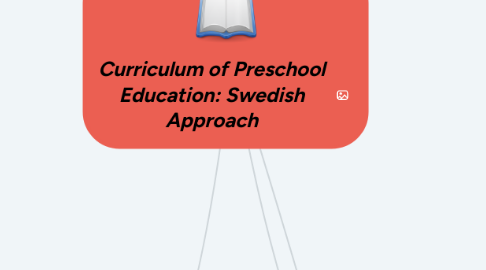
1. Cross Cultural Examples
1.1. Columbia
1.1.1. children who received nutritional supplements without participating in the preschool activities made statistically significant gains in height and weight, but their cognitive abilities did not improve until they entered the preschool
1.2. Europe
1.2.1. children who attended child care programs tended to have higher levels of language skill development and more highly developed play and activity patterns compared to their peer children in family child care homes.
1.3. Turkey
1.3.1. children who attended the educational child care programs performed significantly better than children in custodial child care and home care on almost all measures of cognitive development.
2. Swedish Approach to Education
2.1. Some Facts and Figures
2.1.1. schooling is free
2.1.2. Education is the largest single item in municipal budgets(42%).
2.1.3. 70 % of education is financed by municipaltaxes.
2.1.4. Sweden invests a total of 6.3 percent of GDP on education while the OECD average is 5.7%.
2.1.5. Swedish students have good reading skills.
2.2. Recent changes in the Swedish school system
2.2.1. New education act
2.2.2. New curricula
2.2.3. New grading system
2.2.4. Introduction of teacher certification
3. Conclusions & Recommendations
3.1. well-designed programs with enriched learning experiences, together with parent support, leads to improved social behaviors and enhanced cognitive and linguistic performances for disadvantaged children.
3.2. strong associations between higher quality child care programs and higher scores on measures of cognitive growth, social development and school readiness
3.3. The interests and needs of children are key components of their education in the preschool curriculum.
4. The purpose of this article is to discuss the importance of having preschool education for children to develop their cognitive, affective social and sychomotor characteristics. In this paper cross cultural examples together with the main characteristics of Swedish preschool approach have been presented with a view to inspiring curriculum developers.
5. Introduction
6. Theoretical Framework: Preschool Curriculum & Preschool Children
6.1. Main characteristics of preschool children:
6.1.1. interested in environment.
6.1.2. like being recognized and praised.
6.1.3. sociable and ready to establish good relationships
6.1.4. like being in control as well as adult guidance.
6.1.5. enjoy stories, rhymes, dancing and music.
6.1.6. like the opportunity to voice their opinions and set their own rules.
6.1.7. have natural curiosity
6.1.8. kinesthetic.
6.2. First Things First: Basic needs of preschool children
6.2.1. follow “Health & Safety” rules and regulations.
6.2.2. Balanced and healthy diet
6.2.3. a sense of independence
6.2.4. stimulating and challenging learning environment.
6.2.5. space and fresh air
6.2.6. Well-planned learning activities
6.2.7. Plenty of learning opportunities
6.2.8. the balance of indoor and outdoor activities.
6.2.9. storytelling, music and dancing activities
6.2.10. The needs of children with regard to their cognitive, affective, social and psychomotor
6.3. Curriculum development
6.3.1. Objectives
6.3.2. Subject Matter & Content
6.3.3. Learning Experiences
6.3.4. Evaluation procedures
6.4. Main points to be kept in mind for the success of the curriculum
6.4.1. the range of learning activities is wide and broad enough
6.4.2. constantly observe the progress of each child.
6.4.3. suitable and carefully selected materials
6.4.4. be careful in terms of the difficulty level
6.4.5. the balance right in terms of cognitive, affective, social and physical needs
6.4.6. incorporate process skills into the curriculum.
6.4.7. Presentation and social skills should not be neglected
6.4.8. opportunities for children to be co-operative, patient, respect other children and living things, confident enough to take initiative, sharing, being imaginative,able to take measures against possible accidents (sense of awareness), clean and be aware of hygiene, independent, caring for others
